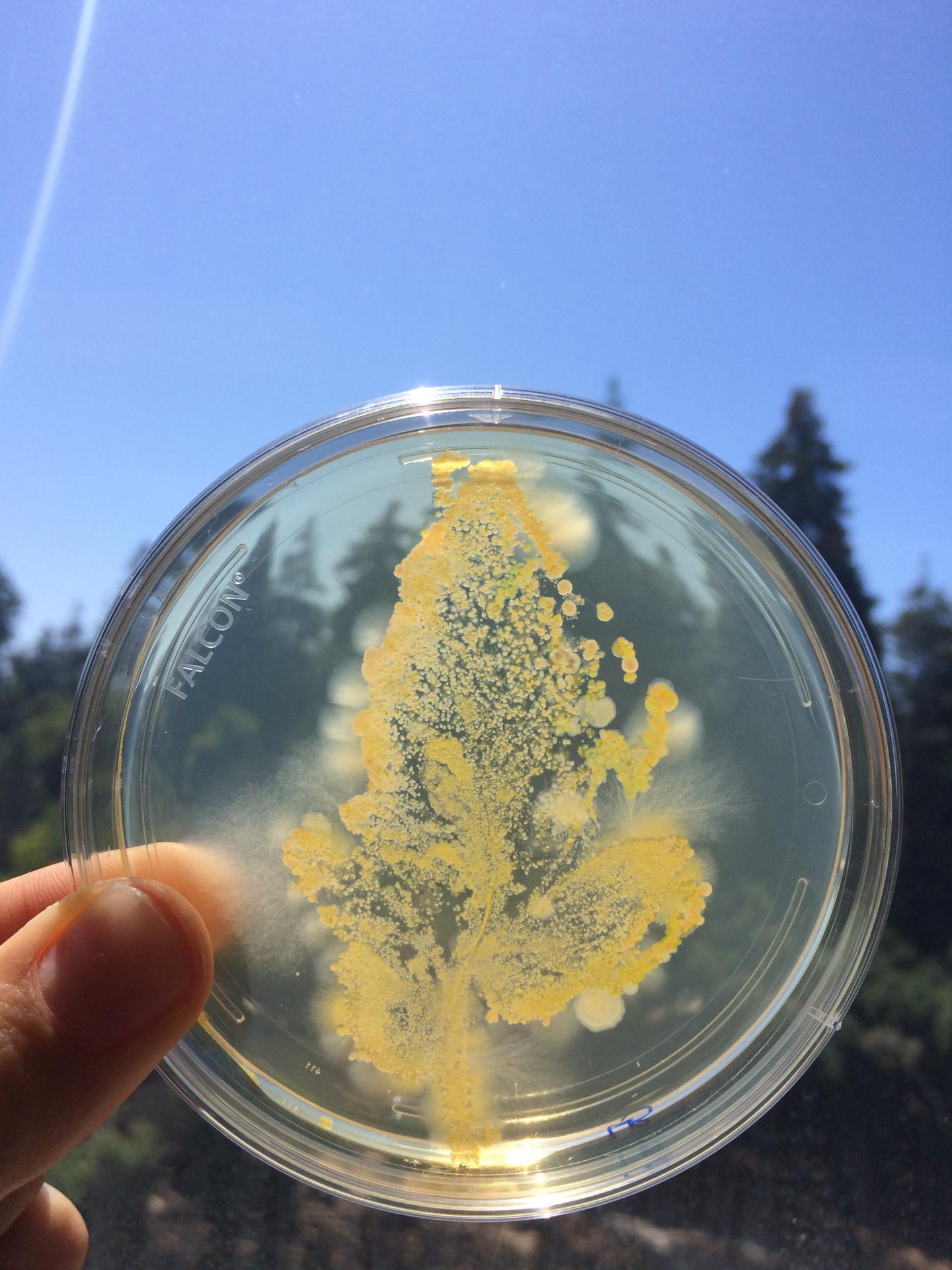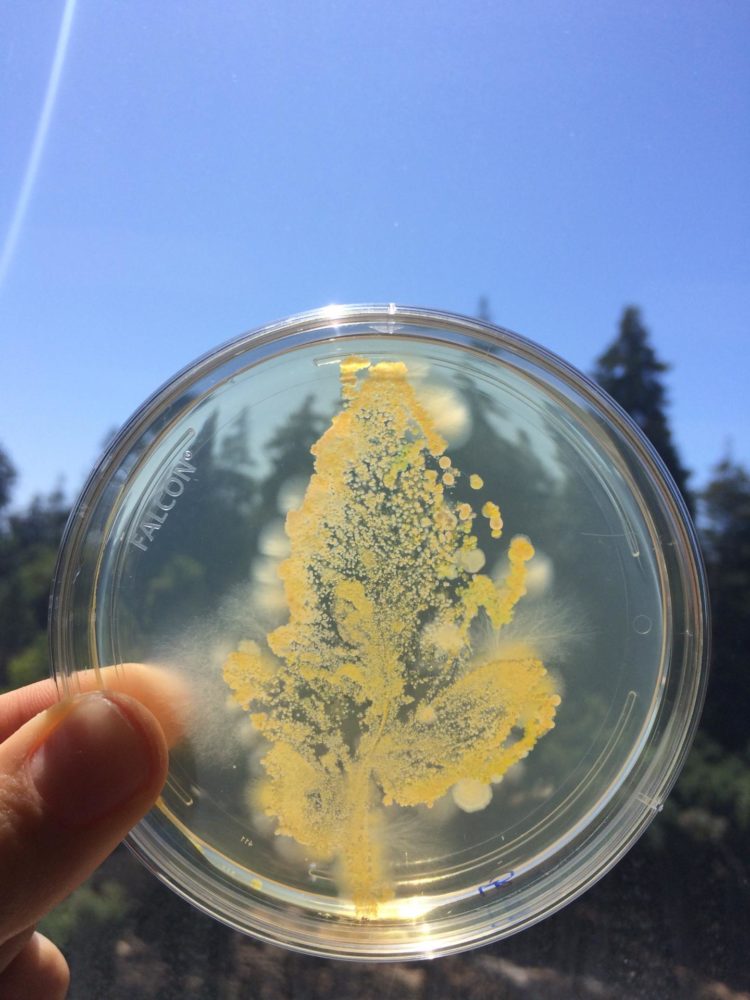Researchers home in on core microbial community of tomato, one that is robust and stable

Credit: Photo courtesy of Britt Koskella lab
Scientists are homing in on what a healthy human microbiome looks like, mapping the normal bacteria that live in and on the healthy human body. But what about a healthy plant microbiome?
Is there even such a thing as a healthy plant microbiome in today’s agricultural fields, with acres of identical plants assaulted by pesticides and herbicides and hyped up on fertilizer?
A new study by University of California, Berkeley, microbial ecologists used experimental evolution to help identify the core microbiome of commercial tomatoes. They selected for those microbial taxa that best survived on the plants and then showed that these “domesticated” microbial communities are able to effectively fend off random microbes that land on the plants. In other words, these selected communities look like a stable, healthy plant microbiome, akin to what a robust tomato plant might pass to its offspring.
The results are good news for growers who hope that manipulating the plant microbiome, perhaps with probiotics, will make for healthier fields that need less fertilizer and less or no pesticides to produce good yields.
“I see the implications of this work not just being about probiotics, but also about guiding agricultural practice,” said study leader Britt Koskella, a UC Berkeley assistant professor of integrative biology. “When planting fields, we should be thinking about how what we do — whether it is age structuring of crops or monocropping versus crop rotations, what is in the soil or what is living nearby — can impact the acquisition and health of the plant microbiome. We should be manipulating the growing conditions in a way that microbial transmission is more akin to what would happen naturally.”
Koskella, lead author Norma Morella, who is now a postdoctoral fellow at the Fred Hutchinson Cancer Research Center in Seattle, and their colleagues reported their findings online this week in the journal Proceedings of the National Academy of Sciences (PNAS).
How do seedlings get microbiomes from their mothers?
Koskella studies the microbial ecology of plants and how it affects plant health, much like biologists study the human microbiome’s role in health. Focusing on agricultural crops, she has some of the same concerns as biologists who worry about the transmission of a healthy human microbiome — skin, gut and more — from mother to baby.
When seedlings are first put into fields, for example, there are often no nearby adult plants from which they can acquire leaf and stem microbes. In the absence of maternal transmission, Koskella wondered, how do these plants acquire their microbiomes, and are these microbiomes ideal for the growing plants?
And, if the microbiomes are not well adapted — for example, not resistant to disease-carrying microbes — can they be improved?
These questions are becoming increasingly important as growers and industry alike try to improve crop yield and sustainability by surrounding seeds with desirable microbes, engineering soil microbial communities or spraying desired microbes on growing plants.
Increasing evidence also shows that microbiomes can affect yield, tolerance to drought and even the flowering time of plants. Can microbiomes be enhanced to achieve this, and will enhanced microbiomes survive long enough to help the plants?
The new study is encouraging.
“We already know that, in theory, you can select for microbes that perform particular functions: increased yield, drought tolerance or disease resistance, for example,” Koskella said. “We are showing here that you can, in principle, create a microbial community that has the function you are interested in, but also is uninvadable, because it is really well-adapted to that plant.”
Cultivating a core microbiome
The researchers’ experiments, conducted in greenhouses on UC Berkeley’s Oxford Tract, involved taking five types of tomatoes and spraying four successive generations of plants with the microbiomes of the previous generation. The first generation was sprayed with a broad mix of microbes found on a variety of tomatoes in an outdoor field at UC Davis.
Nurturing the microbial community of each type of tomato through successive generations allowed it to adapt to each strain, ideally weeding out the maladapted microbes and allowing the well-adapted ones to flourish.
By sequencing the 16S ribosomal subunits of the tomatoes’ microbial communities after each generation — a technique that allows identification of different bacterial taxa — they were able to show that, by the fourth generation, only 25% of the original microbial taxa remained.
“So, 75 percent of the original bacteria that we spray on go virtually extinct during the experiment,” Koskella said. “That is really interesting in itself, because it suggests that a lot of the microbes out there aren’t well adapted, they are kind of there by chance. The wind blew them there, rain splashed them there, but they are not thriving, they are likely not adapted to that particular environment.”
The remaining 25%, which were very similar across all independent selection lines and across the five tomato strains, looked very much like a “core” microbiome: the key microbes necessary for a healthy plant.
When Morella sprayed tomato plants with a microbial mixture — half from the partially adapted microbiome of the first generation, half from the more mature fourth generation microbiome — the fourth generation microbes took over, suggesting that they were much better adapted to the tomato.
“I think this work on the tomato supports the idea that leaf bacteria are probably very distinctive and have traits that are required for them to grow well on those plants, and that just the fact that you can find things there may mean that they are there only transiently and probably in the process of dying,” said co-author Steven Lindow, a UC Berkeley professor of plant and microbial biology who has been investigating plant-pathogen interactions for nearly 50 years. “This is very consistent with what we had found before, that good plant colonists can grow on many plants and, in so doing, usurp the ability of anybody else to also grow there. The prophylactic effect is definitely very strong and real and very important in keeping other plant colonists away.”
“What you want to ask, really, is, ‘Who wins when you put them head to head? The selected microbiome or the unselected microbiome?'” Koskella said. “That, to me, is my favorite part of the whole experiment and was the ‘aha! moment’: Selection works, you really can select for a microbiome that it is well adapted and not invadable, at least under the conditions we used for selection.”
Koskella’s group is now running further experiments to determine whether the selected microbiome actually improves plant health, resilience and productivity, and whether probiotic microbes can be integrated successfully into the core microbiome for lasting crop benefits.
###
The work was supported by the National Science Foundation (DEB 1754494). Other paper co-authors are Francis Cheng-Hsuan Weng of the Academia Sinica in Taipei, Taiwan, Pierre Joubert of UC Berkeley and Jessica Metcalf of Princeton University.
Media Contact
Robert Sanders
[email protected]
510-643-6998
Related Journal Article
http://dx.





